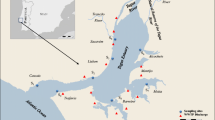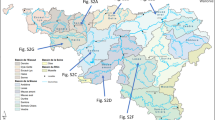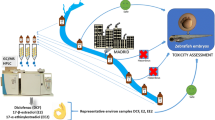Abstract
The presence of substances such as hormones and toxic metal in aquatic ecosystem is interesting to the scientific community due to their adverse effects. We quantified 17α-ethynylestradiol (EE2) and toxic metals in the surface waters from Sorocaba and Pirajibu Rivers, in São Paulo State, and we estimated the daily intake for hormone, based on the amount of water consumed. EE2, Cd, Hg, As, Pb, and Mn were seasonally quantified in six different locations along the rivers. EE2 was evaluated by high-performance liquid chromatography. Toxic metals were determined by inductively coupled plasma mass spectrometer. Considering the entire sample year, EE2 concentrations ranged from 4.5 to 48.2 μg L−1. Comparing Sorocaba and Pirajibu rivers, the sample point in the entrance of the Pirajibu River through the city of Itu, São Paulo State, had higher amounts of EE2. Regarding metals, all results are according to the Brazilian and World Health Organization guidelines for drinking-water quality, except for Mn levels, which were higher than the limits in Autumn season in two locations. The estimated daily intake ranged from 13.45 to 40.9 μg/day/person. In conclusion, concentrations of EE2 in the Sorocaba and Pirajibu Rivers were higher than in other countries. The levels were as high as an intake of one pill for each person every day (considering an oral contraceptive has 0.03 mg of ethinylestradiol). Even though concentrations of toxic elements are in accordance with the Brazilian Regulation and World Health Organization, legislation for hormones and drugs needs to advance.

Similar content being viewed by others
References
Adeel, M., Song, X., Wang, Y., Francis, D., & Yang, Y. (2017). Environmental impact of estrogens on human, animal and plant life: a critical review. Environment International, 99, 107–119.
Andrade, V. M., Aschner, M., & Marreilha Dos Santos, A. P. (2017). Neurotoxicity of metal mixtures. Advances in Neurobiology, 18, 227–265.
Anthuber, S., Schramm, G. A., & Heskamp, M. L. (2010). Six-month evaluation of the benefits of the low-dose combined oral contraceptive chlormadinone acetate 2 mg/ethinylestradiol 0.03 mg in young women: results of the prospective, observational, non-interventional, multicentre TeeNIS study. Clinical Drug Investigation, 30(4), 211–220.
Anual, Z. F., Maher, W., Krikowa, F., Hakim, L., Ahmad, N. I., & Foster, S. (2018). Mercury and risk assessment from consumption of crustaceans, cephalopods and fish from West Peninsular Malaysia. Microchemical Journal, 140, 214–221.
ATSDR (Agency for Toxic Substances and Diseases Registry) ( 2017). Priority list of hazardous substances. https://www.atsdr.cdc.gov/spl. Accessed 21 June 2018.
Australian Government. (2015). Australian Drinking Water Guidelines 6. National Water Quality Management Strategy. Version 3.1.
Beretta, M., Britto, V., Tavares, T. M., Silva, S. M. T., & Pletsch, A. L. (2014). Occurrence of pharmaceutical and personal care products (PPCPs) in marine sediments in the Todos os Santos Bay and the north coast of Salvador, Bahia, Brazil. Journal of Soils and Sediments, 14, 1278–1286.
Bhandari, R. K., Deem, S. L., Holliday, D. K., Jandegian, C. M., Kassotis, C. D., Nagel, S. C., Tillitt, D. E., et al. (2014). Effects of the environmental estrogenic contaminants bisphenol A and 17a-ethinyl estradiol on sexual development and adult behaviors in aquatic wildlife species. General and Comparative Endocrinology. https://doi.org/10.1016/j.ygcen.2014.09.014.
Caldwell, D. J., Mastrocco, F., Hutchinson, T. H., Länge, R., Heijerick, D., Janssen, C., Anderson, P. D., & Sumpter, J. P. (2008). Derivation of an aquatic predicted no-effect concentration for the synthetic hormone, 17 alpha-ethinyl estradiol. Environmental Science & Technology, 42(19), 7046–7054.
Cunha, D. L., Silva, S. M. C., Bila, D. M., Oliveira, J. L. M., Sarcinelli, P. N., & Larentis, A. L. (2016). Regulamentação do estrogênio sintético 17α-etinilestradiol em matrizes aquáticas na Europa, Estados Unidos e Brasil. Caderno de Saúde Pública, 32(3), e00056715.
D’Ascenzo, G., Di Corcia, A., Gentili, A., Mancini, R., Mastropasqua, R., Nazzari, M., et al. (2003). Fate of natural estrogen conjugates in municipal sewage transport and treatment facilities. Science of the Total Environment, 302, 199–209.
Dzieweczynski, T. L., & Buckman, C. M. (2013). Acute exposure to 17alpha-ethinylestradiol disrupts audience effects on male-male interactions in Siamese fighting fish, Betta splendens. Hormones and Behavior, 63, 497–502.
EFSA - European Food Safety Authority. (2009). Scientific Opinion on Arsenic in Food. EFSA Journal, 7(10), 1351.
EPA - Environmental Protection Agency of United States. (2013). Basic information about the unregulated contaminant monitoring rule 3 (UCMR 3). Washington D. C.
European Commission. (2019) Communication from the commission to the European Parliament, the council and the European economic and social committee. European Union Strategic Approach to Pharmaceuticals in the Environment. Brussels. Accessed 22 Oct 2019. Available at https://ec.europa.eu/environment/water/water-dangersub/pdf/strategic_approach_pharmaceuticals_env.PDF.
Gavrilescu, M., Demnerová, K., Aamand, J., Agathos, S., & Fava, F. (2015). Emerging pollutants in the environment: present and future challenges in biomonitoring, ecological risks and bioremediation. New Biotechnology, 32, 147–156.
Grotto, D., Batista, B. L., Carneiro, M. F. H., & Barbosa Junior, F. (2012). Evaluation by ICP-MS of essential, nonessential and toxic elements in Brazilian fish and seafood samples. Food and Nutrition Sciences, 3, 1252–1260.
IBGE - Instituto Brasileiro de Geografia E Estatística (Brazilian Institute of Geography and Statistics). (2016). Cinfográfico do Município de Sorocaba. http://ibge.gov.br/cidadesat/painel/educacao.php?lang=_PT&codmun=355220&search=sao-paulo%7Csorocaba%7Cinfograficos:-escolas-docentes-e-matriculas-por-nivel. Accessed 10 Jan 2018.
Jackson, A. C. (2018). Chronic neurological disease due to methylmercury poisoning. Canadian Journal of Neurological Sciences, 45(6), 620–623.
Jia, Y., Wang, L., Qu, Z., & Yang, Z. (2018). Distribution, contamination and accumulation of heavy metals in water, sediments, and freshwater shellfish from Liuyang River, Southern China. Environmental Science and Pollution Research, 25, 7012–7020.
Jiang, J.-Q., Zhou, Z., & Sharma, V. K. (2013). Occurrence, transportation, monitoring and treatment of emerging micro-pollutants in waste water - a review from global views. Microchemical Journal, 110, 292–300.
Larcher, S., Delbès, G., Robaire, B., & Yargeau, V. (2012). Degradation of 17α-ethinylestradiol by ozonation: identification of the by-products and assessment of their estrogenicity and toxicity. Environment International, 39, 66–72.
Llorca, M., Farré, M., Eljarrat, E., Díaz-Cruz, S., Rodriguez-Mozaz, S., Wunderlin, D., et al. (2017). Review of emerging contaminants in aquatic biota from Latin America: 2002-2016. Environmental Toxicology and Chemistry, 36, 1716–1727.
Loos, R., Marinov, D., Sanseverino, I., Napierska, D., Lettieri, T. (2018) JRC Technical Reports. Review of the 1st Watch List under the Water Framework Directive and recommendations for the 2nd Watch List. . Accessed 22 Oct 2019. Available at https://publications.jrc.ec.europa.eu/repository/bitstream/JRC111198/wl_report_jrc_2018_04_26_final_online.pdf.
Machado, K. S., Cardoso, F. D., Azevedo, J. C. R., & Braga, C. B. (2014). Occurrence of female sexual hormones in the Iguazu river basin, Curitiba, Paraná State, Brazil. Acta Scientiarium Technology, 36, 421–427.
Mandal, B. K., & Suzuki, K. T. (2002). Arsenic round the world: a review. Talanta, 58, 201–235.
Mohod, C. V., & Dhote, J. (2013). Review of heavy metals in drinking water and their effect on human health. International Journal of Innovative Research in Science, Engineering and Technology, 2, 2992–2996.
Myers, G. J., Davidson, P. W., Cox, C., Shamlaye, C. F., Palumbo, D., Cernichiari, E., Sloane-Reeves, J., Wilding, G. E., Kost, J., Huang, L. S., & Clarkson, T. W. (2003). Prenatal methylmercury exposure from ocean fish consumption in the Seychelles child development study. Lancet, 361, 1686–1692.
O’Neal, S. L., & Zheng, W. (2015). Manganese toxicity upon overexposure: a decade in review. Current Environmental Health, 2, 315–328.
Opasola, O. A., Adeolu, A. T., Iyanda, A. Y., Adewoye, S. O., & Olawale, S. A. (2019). Bioaccumulation of heavy metals by Clarias gariepinus (African catfish) in Asa River, Ilorin, Kwara State. Journal of Health & Pollution, 9, 2–9.
Padilha, C. F., & Leitzke, F. L. S. (2013) Determinação de hormônios sexuais femininos na bacia do Alto Rio Iguaçu na região de Curitiba –PR. 2013. 58 p. Universidade Tecnológica Federal do Paraná, Curitiba.
Pailler, J. Y., Krein, A., Pfister, L., Hoffmann, L., & Guignard, C. (2009). Solid phase extraction coupled to liquid chromatography-tandem mass spectrometry analysis of sulfonamides, tetracyclines, analgesics and hormones in surface water and wastewater in Luxembourg. Science of the Total Environment, 407, 4736–4743.
Pal, D., & Maiti, S. K. (2018). Heavy metal speciation, leaching and toxicity status of a tropical rain-fed river Damodar, India. Environmetal Geochemistry and Health. https://doi.org/10.1007/s1065301800979.
Patrick, L. (2006). Lead toxicity. A review of the literature. Part I: exposure, evaluation, and treatment. Alternative Medicine Review, 11, 2–22.
Pedron, T., Segura, F. R., Silva, F. F., Souza, A. L., Maltez, H. F., & Batista, B. L. (2016). Essential and non-essential elements in Brazilian infant food and other rice-based products frequently consumed by children and celiac population. Journal of Food Compostion and Analysis, 49, 78–86.
Peres, T. V., Schettinger, M. R. C., Chen, P., Carvalho, F., Avila, D. S., Bowman, A. B., et al. (2016). Manganese-induced neurotoxicity: a review of its behavioral consequences and neuroprotective strategies. BMC Pharmacology and Toxicology, 15, 17–57.
Phillip, A. T., & Gerson, B. (1994). Lead poisoning – Part I. Incidence, etiology, and toxicokinetics. Clinics in Laboratory Medicine, 14, 423–444.
Pimentel, M. F., Damasceno, E. P., Jimenez, P. C., Araújo, P. F. R., Bezerra, M. F., Morais, P. C. V., et al. (2016). Endocrine disruption in Sphoeroides testudineus tissues and sediments highlights contamination in a northeastern Brazilian estuary. Environmetal Monitoring Assessment. https://doi.org/10.1007/s1066101653009.
Rahimzadeh, M. R., Rahimzadeh, M. R., Kazemi, S., & Moghadamnia, A.-A. (2017). Cadmium toxicity and treatment: an update. Caspian Journal of Internal Medicine, 8, 135–145.
Rahman, Z., & Singh, V. P. (2019). The relative impact of toxic heavy metals (THMs) (arsenic (As), cadmium (Cd), chromium (Cr)(VI), mercury (Hg), and lead (Pb)) on the total environment: an overview. Environmental Monitoring and Assessment, 191, 419–440.
Snyder, S. A., Westerhoff, P., Yoon, Y., & Sedlak, D. L. (2003). Pharmaceuticals, personal care products, and endocrine disruptors in water: implications for the water industry. Environmental Engineering Science, 20, 449–469.
Torres, N. H., Aguiar, M. M., Ferreira, L. F., Américo, J. H., Machado, A. M., Cavalcanti, E. B., et al. (2015). Detection of hormones in surface and drinking water in Brazil by LC-ESI-MS/MS and ecotoxicological assessment with Daphnia magna. Environmental Monitoring and Assessment. https://doi.org/10.1007/s106610154626z.
WHO - World Health Organization. (2017) Geneva, Guideline 4th ed.
Xu, W., Yan, W., Huang, W., Miao, L., & Zhong, L. (2014). Endocrine-disrupting chemicals in the Pearl River Delta and coastal environment: sources, transfer and implications. Environmental Geochemistry and Health, 36, 1095–1104.
Zhang, Z., Feng, Y., Gao, P., Wang, C., & Ren, N. (2011). Occurrence and removal efficiencies of eight EDCs and estrogenicity in a STP. Journal of Environmetal Monitoring, 13, 1366–1373.
Author information
Authors and Affiliations
Corresponding author
Ethics declarations
Conflict of interest
The authors declare that they have no conflict of interest.
Additional information
Publisher’s note
Springer Nature remains neutral with regard to jurisdictional claims in published maps and institutional affiliations.
Rights and permissions
About this article
Cite this article
de França, J.F., Pickler, T.B., Jozala, A.F. et al. Determination of 17α-ethinylestradiol and toxic metals in surface waters, and estimation of daily intake. Environ Monit Assess 192, 21 (2020). https://doi.org/10.1007/s10661-019-7990-2
Received:
Accepted:
Published:
DOI: https://doi.org/10.1007/s10661-019-7990-2




